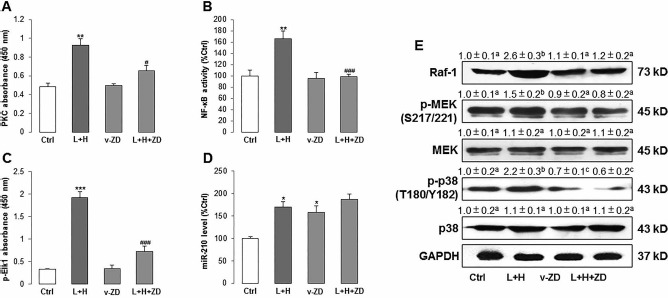Figure 2.

ZD ameliorates PKC/Raf-1/MAPK/NF-κB pathway activity, which was activated by LPS/H2O2 in hADMSCs. (A-C) PKC activity, NF-κB (p65), and phosphorylated Elk1 level were measured after LPS/H2O2 incubation with or without ZD cotreatment. (D) The expression level of miR-210 was measured after LPS/H2O2 incubation with or without ZD cotreatment. (E) Western blot results of Raf-1, phosphorylated MEK, total MEK, phosphorylated p38 MAPK, and total p38 MAPK after LPS/H2O2 incubation with or without ZD cotreatment. *p < 0.05, **p < 0.01, 096368916X694274p < 0.001 mean significant changes between control and treatment groups, respectively; #p < 0.05, ###p < 0.001 mean significant changes between indicated treatment and LPS/H2O2 incubation group, respectively. (E) Different letters (e.g., a vs. b, b vs. c) indicate a significant change between compared groups (p < 0.05). The same letters (e.g., a vs. a, c vs. c) indicate there is no significant change between compared groups (p > 0.05). Ctrl, control; ZD, zeaxanthin dipalmitate; L+H, LPS/H2O2; v-ZD, vehicle-ZD treatment; hADMSCs, human adipose-derived mesenchymal stem cells; LPS, lipopolysaccharide; PKC, protein kinase C; NF-κB, nuclear factor κB; Elk1, ETS domain-containing protein; miR-210, microRNA-210; Raf-1, RAF proto-oncogene serine/threonine protein kinase; MEK, mitogen-activated protein kinase; p38, p38 mitogen-activated protein kinase; GAPDH, glyceraldehyde 3-phosphate dehydrogenase.
